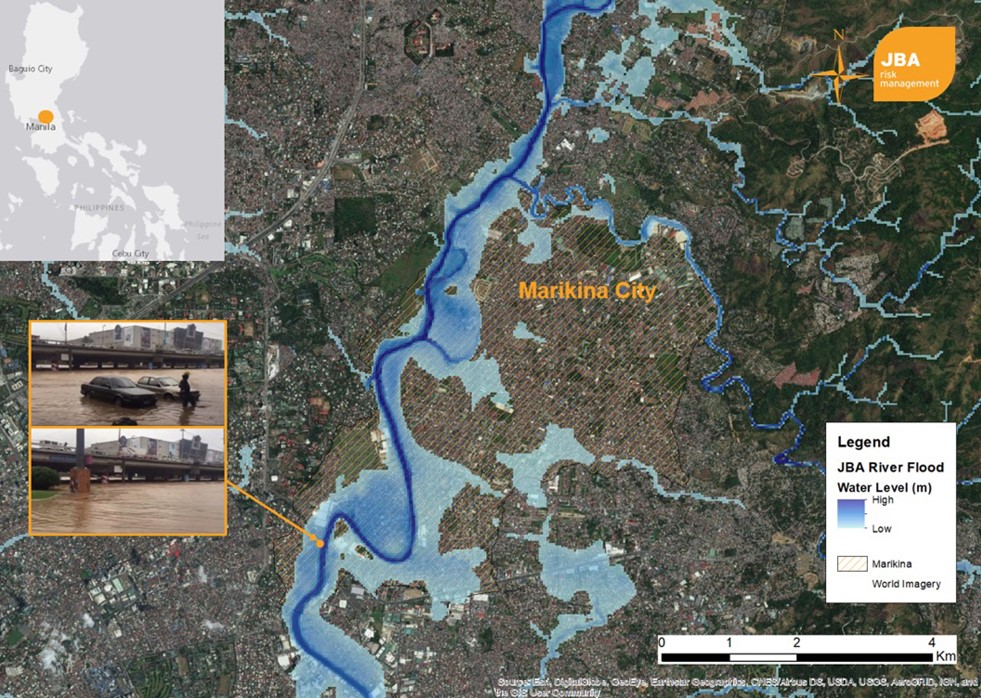Half of August’s rainfall fell in a single day on the Philippine island of Luzon this weekend. The floods were the result of both Tropical Storm Yagi and the Southwest Asian monsoon.
High levels of precipitation over the weekend triggered flooding across various cities, including the capital city of Manila, Philippines. The event has caused widespread disruption with 54,000 evacuated as the Marikina River burst its banks.

Illustration of flooded location around the Marikina City region of Manila. JBA Philippines River Flood Map (20-Year Return Period) is provided for context (JBA Risk Management Limited TM).
It is the annual wet season in the Philippines, with the monsoon season occurring from May to October alongside the upcoming typhoon season. The Philippines encounters an average of 20 typhoons annually.
Over the weekend, Tropical storm Yagi passed north of the Philippines before making landfall in Zhejiang, China. Despite the distance between Yagi and Metro Manila, the powerful tropical storm further enhanced monsoonal rainfall in Metro Manila and other regions such as Rizal and Bulacan. On Saturday (11 August 2018), the central Luzon area received half of the precipitation expected for the whole month of August in just one day (PAGASA). Due to the persistent rainfall, several regions were given the red alert (the highest tier for the flood warning system in Philippines) and advised to take precautionary measures against possible flooding and landslides (PAGASA).
Marikina City was one of the cities worst affected by the floods with approximately 22,000 Marikenos evacuated to shelters when the red-alert was issued. The local authorities evacuated people forcefully to prevent extra casualties as river levels continued to increase. The height of the river peaked at 20.6m on 23:00 PST, 11 August 2018. It has been reported by the National Disaster Risk Reduction and Management Council (NDRRMC) that the total cost of assistance for this event will be approximately PHP 14.7 million (USD $270,000), with Marikina City accounting for ~77% of this total. However, economic losses and costs incurred due to damaged properties and contents are likely to be more significant.
A summary of past flood events in Marikina city

It is not unusual for Marikina City to experience flooding along the Marikina river. In 1992, flooding from the Marikina river inundated 27% of the city and 10,000 houses were found to be at risk of flooding (Asian Disaster Preparedness Centre). In 2009, Tropical Strom Ondoy delivered a month’s worth of rainfall on Metro Manila within 12 hours on 26 September 2009. The 2009 event remains etched in people’s memory. The Marikina river peaked at 23.6m and was accountable for 465 deaths in Metro Manila, with total damages of PHP 10.9 billion (USD $200 million).
The recent flooding is not in isolation: the Philippines has a high exposure to various natural perils. Rainfall and strong winds repeatedly cause casualties and damage to properties. On average, such natural hazards cost approximately 1% of the national GDP. Non-life insurance penetration in the Philippines is estimated at 1.9% of GDP (Oxford Business Group). This is slightly higher than many neighbouring countries such as Sri Lanka (1.2%) and Vietnam (1.6%), but quite far behind others in the region such as Malaysia (5%) and Thailand (6%).
JBA Risk Management has nationwide return period flood maps for the Philippines at 30m resolution. Please get in touch for further information.
References
Iglesias, G. and Yu, Carlyne., 2008, 'Flood Mitigation and River Rehabilitation by Marikina City, Philippines', Asian Disaster Preparedness Centre, viewed 8 August 2018
Oxford Business Group, 2017, 'Philippine Insurance Sector Sees Premiums and Penetration Rise', viewed 8 August 2018
Philippines Atmospheric Geophysical and Astronomical Services Administration, 2018, 'Tropical Storm KARDING (Yagi/ 1814) Summary Report', viewed on 8 August 2018